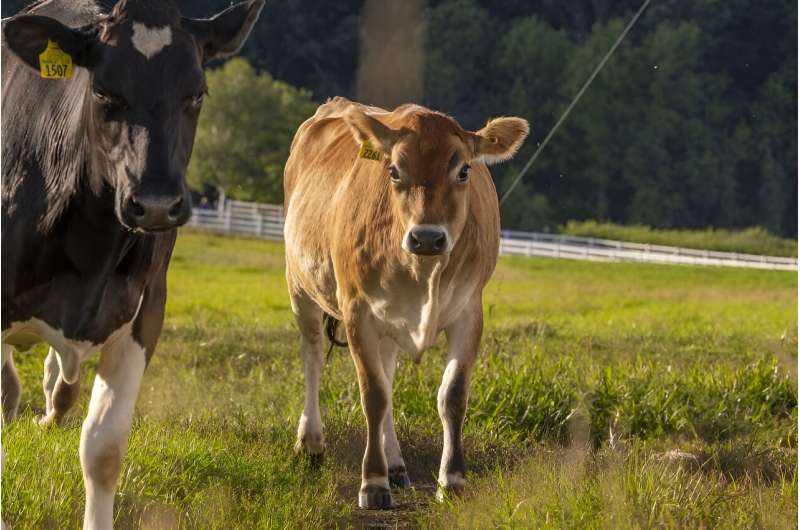This article has been reviewed according to Science X's editorial process and policies. Editors have highlighted the following attributes while ensuring the content's credibility:
fact-checked
peer-reviewed publication
trusted source
proofread
Historic genome sequencing will unlock potential for agriculture, conservation

A multi-institutional, international effort known as the Ruminant Telomere-to-Telomere consortium, or RT2T, is aiming to make scientific history by publishing the complete genomes of more than 300 species of ruminant animals, ranging from narwhals to dairy cows.
This initiative builds on other recent T2T consortium successes, such as the June 2024 publication of the complete sequencing of six ape species genomes and the August 2023 publication of the first-ever complete human Y chromosome sequence.
At UConn, Rachel O'Neill, director of the Institute for Systems Genomics and Board of Trustees Distinguished Professor of molecular and cell biology, has had a hand in all these victories.
For the RT2T, O'Neill explains, "My lab is generating some of the data, and we're doing quite a bit of biobanking of cell lines—establishing cell lines for many of the endangered or critically endangered species, where there isn't a repository that exists already."
The O'Neill lab will also be responsible for performing the repeat analysis—detangling and decoding many thousands of repeated, short sequences of DNA—for each species.
"That's kind of a giant task, because the largest amount we've ever done before is what we just completed for the primates—six species," O'Neill says.
Historically, studying ruminant animal genetics has been challenging due to missing, incomplete and/or fragmented reference genome sequences. The RT2T project aims to use cutting-edge sequencing technologies and collaborative expertise to eliminate many of these barriers.
In an article published in Nature Genetics, the T2T team describes how they will leverage advanced sequencing technologies to analyze the genomes of ruminant species. These methods provide a comprehensive view of the genome, including previously hard-to-sequence chromosomal regions like centromeres and telomeres, creating complete genetic blueprints of these animals.
Without those genetic blueprints, O'Neill explains, "conservation management strategies become impossible; understanding genome biology becomes impossible, because we're literally blind. It's like having a book with every third word cut out randomly and having to decipher its meaning."
Scientists worldwide can access data from the RT2T to conduct further studies, multiplying the project's potential impact on agriculture and conservation efforts.
The future of genomic research in agriculture
For livestock ruminants (sheep and cattle), genomic research can help enable more efficient dairy and meat production and help reduce the risk of infectious diseases spreading from livestock to humans.
This "dovetails quite well" with UConn's strengths in research agriculture, according to O'Neill.
"It's quite fortuitous that this is happening," she says. "I've collaborated with several labs over the past 10 to 15 years where Ph.D. students were desperate for a good genome assembly, and it's refreshing to be able to say one is really coming and to invite those teams to play with that genome as it comes out."
As the RT2T project advances, its research is anticipated to also shed light on the evolutionary biology of ruminants. This will allow breeders to implement strategies to help conserve valuable genetic traits and ensure animals can successfully adapt to changing environmental conditions.
Applications in conservation and biodiversity management
In addition to agricultural benefits, the comprehensive genome data produced by the RT2T can play a critical role in conservation efforts. High-quality genomic information is essential for managing the genetic diversity of endangered ruminant species and developing strategies to improve their populations' survival chances.
Genome sequencing can unlock the entire genetic history of a population. For example, O'Neill says, conservation managers can use it to determine whether a population has undergone inbreeding, which can harm its long-term survival, and help re-diversify it by translocating individual animals from other populations.
If a group of animals is discovered to have inbreeding depression, O'Neill explains, "That means they've gone through some sort of population decline at some point. And we can, from one genome, look into the past and actually model population density over time and figure out, is that population crash recent? Is it because of the Anthropocene, or is it more ancient? Those are the kinds of things conservation managers are looking for."
More information: Theodore S. Kalbfleisch et al, The Ruminant Telomere-to-Telomere (RT2T) Consortium, Nature Genetics (2024). DOI: 10.1038/s41588-024-01835-2
Journal information: Nature Genetics
Provided by University of Connecticut



















